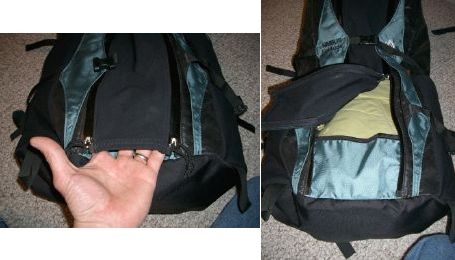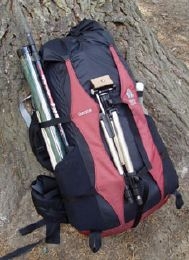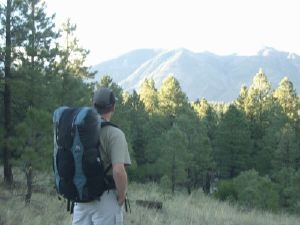Overview

Photo 1: Ryan Jordan, carrying Granite Gear’s Nimbus Ozone, and dog Maia in the Bitterroot Wilderness.
Granite Gear’s Nimbus Ozone (top loading) and Nimbus Latitude (panel loading) are exceptionally comfortable lightweight packs designed for 40-pound (18 kg) loads. Granite Gear uses soft padding in their shoulder straps that conforms well to the shape of shoulders and collarbones and better distributes the weight of a loaded pack. The Tepex composite frame used in the Nimbus series offers greater adjustability than that found in similarly priced and sized packs. Torso length and shoulder width are both adjustable. The packs have some of the best load compression in the industry. One complaint with both the Nimbus Ozone and Nimbus Latitude is that the load compression straps cut across the top of the side pockets making it difficult to access items unless the strap is loosened. Both packs are heavier than many ultralight internal frame packs that use less rugged fabrics, lighter albeit not as stiff frames, and less padded harnesses.
Specifications
|
• Backpack Style |
Nimbus Ozone – top loading internal frame backpack with roll-top closure Nimbus Latitude – panel loading internal frame backpack |
|||||||||
|
• Fabric Description |
70d 2.4 oz/yd2 (81 g/m2) silnylon, reinforced by 210d, 6.5 oz/yd2 (221 g/m2) hybrid HT Cordura in high stress and high wear areas. Both packs feature 8.5 oz/yd2 (288 g/m2) Durastretch fabric on the side pockets. Durastretch is a waterproof / breathable, laminated, stretch woven fabric with DWR surface treatment. The Nimbus Latitude has an additional section of Durastretch between the two panel loading zippers. | |||||||||
|
• Sizes (Size regular tested in both Nimbus Ozone and Nimbus Latitude) |
|
|||||||||
|
• Volume (Short and Regular volumes are the same for both the Nimbus Ozone and Nimbus Latitude packs) |
|
|||||||||
|
• Weight (Size Regular tested) |
|
|||||||||
|
• Volume to Weight Ratio |
Nimbus Ozone – 78 Nimbus Latitude – 67 (based on Regular size volume and Backpacking Light measured weight (ci/oz) |
|||||||||
|
• Load Carrying Capacity |
40 lbs (18 kg) as claimed by Granite Gear and confirmed by Backpacking Light | |||||||||
|
• Carry Load to Pack Weight Performance Ratio |
Nimbus Ozone – 13 Nimbus Latitude – 11 (based on Backpacking Light confirmed carrying capacity and Backpacking Light measured pack weight) |
|||||||||
|
• MSRP |
Nimbus Ozone – $200 Nimbus Latitude – $230 |
|||||||||
|
• Manufacturer’s Contact Information |
Granite Gear, 218-834-6157 http://www.granitegear.com |
Features
Numerical ratings follow on a scale of 1 to 5 (1=poor, 5=excellent), and are relative to other internal frame packs tested by Backpacking Light.
Frame and Suspension – 4.5

Photo 2: Granite Gear’s Tepex Frame used in their Nimbus Ozone and Nimbus Latitude packs.
Granite Gear’s Nimbus Ozone and Nimbus Latitude share the same frame and suspension system. Setting these packs apart from the rest of the market is a three dimensionally molded Tepex composite frame (Photo 2). The Tepex frame lacks any similarity to the industry standard, a thin plastic HDPE framesheet and aluminum stays. It resembles a framesheet but is much stiffer, eliminating the need for an aluminum stay. Rather than being stiff just down the center (along an internal stay), the Tepex frame is stiff and supportive throughout. The drawback with this type of frame is that it cannot be shaped to custom match individual back curvature. However, our samples approximated correct spinal shape to keep our reviewers comfortable.
The Nimbus series have harnesses that include shoulder straps, sternum strap, padded hip belt, and shoulder straps and hip belt stabilizers. The padding used in the shoulder straps and hip belt is luxurious. Our female reviewers like its suppleness which distributes loads over a large area and avoids concentrating pressure on high spots (particularly shoulders and collar bones and the top of the hips). Both the shoulder straps and hip belt bolt directly to the Tepex composite frame for a rigid link between harness and pack. The harness attaches to the frame by inserting metal bolts through grommets in the shoulder straps and hip belt that screw into blind bolts behind the Tepex frame. The Tepex frame has been drilled to provide multiple attachment options for the harness. In addition, the shoulder straps have three grommet holes to extend their length and distance apart. The adjustability provided in this arrangement far exceeds that found in other internal frame packs by allowing both torso length and shoulder width adjustments. Note: this adjustment requires a screwdriver that should be carried on a few trips until the fit is dialed in.
Usable Features and Ease of Use – 3.5
Both of these packs have two water bottle sized pockets made of Durastretch fabric at the bottom of the side panels. These easily hold liter-sized bottles. The smooth Durastretch fabric does not hang up on Platypus bag-type bottles. The high position of the side pocket makes access difficult while wearing the pack (e.g. removing a water bottle while hiking). In addition, the lower compression straps cross over the top of these pockets. This makes removing stowed gear almost impossible unless you loosen the strap.
Both packs feature two ice axe loops. The upper shaft of an ice axe in the loop goes underneath the upper side panel compression strap. We had some concern that the axe shafts might abrade the side panel’s 2.4 oz/yd2 (81 g/m2) silnylon fabric. So far, we haven’t had any problems in the field.
These packs feature a hydration port and an internal hydration sleeve located against the back panel. A removable shock cord compression system holds the hydration bladder tightly against the back panel. Like most hydration pockets of this design, the contents of the pack must be partially removed in order to refill the bladder. This is a pain on the trail.

Photo 3: There is a thin slit in the bottom of the Granite Gear Nimbus Latitude between the panel loading zippers. Although somewhat unnerving, we were unable to intentionally cause items to fall through due to the tightness of the Durastretch material and the overlap between the Durastretch and Cordura.
Granite Gear’s panel loading Nimbus Latitude has two YKK #8 weather resistant coil zippers running up from the upper back panel, over the top of the pack, and down to the bottom. They are separated by 5-inches (13 cm) of Durastretch material. As the name implies, this material stretches to allow a minimal amount of overstuffing and to reduce the chance of zipper failure. The panel loading design gave us easy access to packed contents. Behind these two panel-loading zippers, Granite Gear has added two internal compression straps mirroring the two on the outside of the pack. These compression straps allow the user to pack the contents of the pack while the zippered panel section is completely open. Once packed, the interior compression straps are tightened making it easier to zip the pack shut. One caveat with this design is an un-sealable 5-inch (13 cm) wide slit at the bottom of the pack, at the lower edge of the Durastretch panel (Photo 3). There is a 4-inch (10 cm) piece of overlapping fabric between the opening and interior of the pack. We explored the possibility of adding Velcro to the bottom of the Durastretch material to secure this opening. However, the designers at Granite Gear avoided Velcro in this area because it will eventually wear out and abrade the fabric it comes in contact with. They also claim to have 10,000 documented miles (16,000 km) with this design without any losses through this opening. We were unable to intentionally make an item fall out with the pack properly loaded and securely compressed.
The Nimbus Latitude has an unusual internal pocket. It is essentially a short, fat stuff sack with a thin piece of perforated closed cell foam supporting the bottom and a draw cord closure. The pocket attaches to the inside of the pack via two small side release buckles. We opted to leave it out during testing in lieu of a stuff sack or two of our own, which proved to better fill the interior volume of the pack and weighed less.
Load Volume Flexibility (Compression) – 5.0

Photo 4: Granite Gear Nimbus Ozone showing various options for stowing gear using the outer compression straps.
Granite Gear has one of the best compression systems on the market for their Ultralight Packer series. Both the Nimbus Ozone and Nimbus Latitude use two sets of three compression straps that encircle the side panels and back of the packs. The compression straps create two continuous lines of compression over both the upper and lower portion of the packs. These packs can handle compression of full volume loads down to day trip sized loads with ease.
In addition to the horizontal compression straps, the top-loading Nimbus Ozone has a roll-top closure similar to that found on the Granite Gear Virga and Vapor Trail backpacks. Two compression straps cross over each other on the top of the pack, one that provides the roll top closure similar to a dry bag, and the other that provides over-the-top compression similar to compression straps used to secure climbing ropes on alpine packs.
Both the Nimbus Ozone and Nimbus Latitude offer excellent load volume flexibility for long hikes without re-supply or for alpine climbing. For example, we used the Nimbus Ozone as a winter alpine climbing approach pack. The backpack was large enough to accommodate a mountain tent (Integral Designs MK1 Lite), synthetic 20 °F (-7 °C) sleeping bag (The North Face Cat’s Meow), synthetic winter insulating clothing (parka and pants), skis, and other shared climbing and camping gear (including a white gas stove, 2 liter cook pot, ice tools, ropes, and a full rack of slings, ice screws, and pitons) and still left enough room in the extension collar for 4-5 days of food. Upon reaching the base of a climb, the pack compressed very well to remain stable for easy-to-moderate ice climbing in alpine couloirs.
If you need to extend the volume beyond the 3,800 cubic inches (62 L) mark, gear can be attached behind the compression straps on the outside of these packs (Photo 4). The Granite Gear Nimbus Latitude excels here as the compression straps crossing the back of the pack are connected with side release buckles (a necessity for the panel access) and can be opened to readily accept gear. The Nimbus Ozone, on the other hand, uses ladder locks in this location requiring items to be slipped into position from the top.
Because the Nimbus Latitude is a panel loading pack, it lacks the additional storage provided by an extension collar. Granite Gear’s Nimbus Ozone has a short extension collar at its upper opening.
Field Performance
Pack Load Carrying – 4.5
Backpacking Light’s testing confirms the load carrying performance of the Nimbus Series meets Granite Gear’s claim of 40 pounds (18 kg). Although we were regularly able to carry more than forty pounds in the pack with no ill effects, many testers had hipbelt discomfort with loads of 45 pounds (20 kg) and higher. We fitted the pack to several people in the recommended torso size range (men and women) and found that the contoured and shaped hip belt did not perfectly fit everyone’s body type. Perhaps a flatter (not pre-molded/contoured), thinner (and thus, more likely to conform to people’s hip shapes), but wider (to increase load bearing surface area) hip belt would carry loads as well and increase comfort for a wider range of body types.
For three out of five testers, carrying loads higher than 45 pounds (20 kg) for more than 10 miles (16 km) a day caused some pain in the iliac crest area. The cause of the pain was the collapse of the hip belt under heavier loads. The belt no longer spread the pack’s load evenly across the hips but concentrated pressure at the top of the iliac crest, which resulted in substantial discomfort. Thus, we estimate the reasonable “long-distance” load carrying capacity of the Nimbus Ozone and Latitude to be about 40 pounds (18 kg), consistent with Granite Gear’s claim.
Durability – 3.5

Photo 5: Jay Ham carrying Granite Gear’s Nimbus Latitude. Note the exposed silnylon on the upper side panels; an area on both the Latitude and the Ozone that necessitates cautious bushwhacking.
Due to the use of 2.4 oz/yd2 (81 g/m2) silnylon in areas that are prone to abrasion, including the lower back panel, upper side panels, and extension collar (Nimbus Ozone only), the Ozone and Latitude have some durability limitations. Increasing the height of the bottom reinforcing fabric a few inches would protect the lower back panel. If you are using the extension collar on the Nimbus Ozone, its light fabric will be exposed while bushwhacking or scrambling. Most other backpacks which use similarly light extension collar fabrics have a top lid that generally protects the collars from abrasion. Granite Gear might consider offering a modular top “flap” or an extension collar using more durable fabric to decrease the extension collar’s vulnerability to abrasion.
The Nimbus Latitude, which doesn’t have an extension collar, does have the heavier weight hybrid Cordura and Durastretch material on its top. Wear in this area from bushwhacking is not as much of a concern. However, the upper side panels, made of 2.4 oz/yd2 (81 g/m2) silnylon are exposed in both of these packs (Photo 5). This area is susceptible to abrasion while bushwhacking, and care must be taken to avoid damage.
The side pockets are not durable enough to withstand repeated stowage of metal-edged skis; we found the pockets had holes from ski edges after only a few days of hiking with skis in the pockets. This problem was alleviated by inserting ski tails first into some custom-sewn Cordura sleeves prior to stowing them in the pockets.
Value – 3.5
At $200 and $230 for the Nimbus Ozone and Nimbus Latitude respectively, these packs are not exactly inexpensive. However, they offer a comfortable carry, top-notch construction and materials, and are reasonably light for packs capable of carrying the weight and volume these packs can haul. Attributes that downgraded the value rating include the inaccessible side pockets and unprotected, less durable fabric in highly exposed areas.
Recommendations for Improvement
A few recommendations: first correct the conflict of the lower side-panel compression straps limiting access to the side pockets. One solution would be to run the compression straps behind each pocket. One could do this by adding two small slits along the sides of the pockets so that the compression straps would run through and underneath the pocket. Adjusting the compression straps would become more cumbersome; however, this is usually done with the pack off and would be easier than trying to get a water bottle back into the pocket while moving in the current configuration. If one was concerned with the lower opening on the Nimbus Latitude’s Durastretch panel access, a small amount of sewing skill and a bit of Velcro could easily seal this opening during the hike while maintaining access to the zippered panel.


